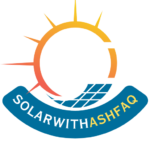Solar Power Effective Use in Winter Season
Are you worried about your solar energy not being effectively used during the winter months?
As the days get shorter and colder, many people struggle to make full use of their solar energy systems.
But don’t worry! There are smart and simple ways to continue using solar energy effectively, even in winter.
Because winter doesn’t mean you have to stop using solar energy!
In this guide, I’ll explore easy solutions to help you shift essential home devices to solar power.

Use Solar Power for Water Heating
To efficiently use solar power for water heating in the winter, it’s important to first understand the different ways you can use solar energy for this purpose.
Here are three possible scenarios and solutions for using solar power:
If You Have an Electric Geyser
If you already have an electric geyser then you don’t need to make extra effort to run it on solar panels.
Just shift the connection from grid supply to solar.
However, you need to engage an electrician to connect and install a separate breaker for the geyser.
If You Have a Gas Geyser
If you already have a gas geyser, don’t worry, you can convert it to electric with a simple alteration. Here are the steps involved:
Safety First: Ensure that the gas supply is completely shut off and disconnected before beginning any work.
Remove Gas Burner Assembly: Take out the gas burner assembly that is no longer needed for electric operation.
Install an Electric Heating Element: Choose an electric heating element (easily purchased from the market) that fits your geyser. Common wattages for residential use range from 1,500 W to 2,000 W.
Install a Thermostat: If your geyser does not already have one, install a thermostat that can control the water temperature automatically.
Wiring: Connect the heating element to a suitable electrical supply of solar panels.
Check out this video for a complete practical setup.
Install Solar Water Heating System
If you don’t already have solar panels, installing a standalone solar water heater is a great option. These systems come with built-in solar collectors, so there’s no need for separate panels.
For more details, check out this complete guide on solar water heating systems.
Install Solar Batteries for Night Use
To make the most of solar power during winter, it’s a good idea to install solar batteries.
Why are batteries so important in winter?
In colder months, most of a home’s energy is used at night. This is because nights are longer, and people use more electric heaters and lights.
When choosing a battery, you can pick the type that best fits your needs and budget. Two popular options are:
- Lithium-ion Batteries: These are popular for their high energy density and longer lifespan.
- Lead-acid Batteries: More affordable but generally have a shorter lifespan and lower depth of discharge.
Cooking with Electric Stoves that Run on Solar Panels
You will be pleased to know that solar-powered stoves are now available in the market.
So why spend a lot of money on filling gas cylinders or using expensive grid electricity in case you already have an electric stove?
These stoves run on just a 12V supply and are very energy efficient as compared to traditional electric stoves.
Use Solar Inverter AC To Warm Your Rooms
Solar inverter ACs are designed to both cool and heat spaces.
Here is the good news: The electricity consumption of these inverters in heating mode is lower than in cooling mode.
You can get the most out of the heating of the inverter if you have battery storage— as you will use the inverter mostly when there is no sun.
Improve your home’s insulation and seal any air leaks around windows and doors. This helps retain heat generated by the solar inverter AC.
Use Solar-Powered Water Pumps
In this guide, our goal is to shift as many appliances to solar power as possible.
Why not include water pumps, which are essential in every home?
Solar energy use is growing in agriculture, and the same can be done at home. Both mono-block and submersible motors can run on solar power, as long as the panels have enough capacity.
If you want to power only the water pump with solar energy, a 3kW solar system is more than enough to do the job.
Use Solar-Powered Electronic Devices as Much as You Can
Solar power is not for some specific appliances. It’s for all.
Despite shifting energy-hungry appliances to solar power, other electronic devices can also use solar energy.
You can include the following items based on their availability in the market (or they can be easily purchased from online marketplaces).
- Portable Solar Chargers: Ideal for charging small devices like smartphones and tablets, these chargers are lightweight and easy to carry. They are useful for outdoor activities like hiking during the winter months.
- LED Solar Lights: These lights can illuminate pathways, gardens, and driveways.
- Solar Refrigerators: They use solar energy to keep food cold and are particularly valuable in remote areas or during power outages.
- Solar DC Fans and Heaters: Some solar-powered fans can help circulate warm air indoors, while solar heaters provide supplemental heat without relying on traditional energy sources.
Charge Electric Vehicles at DayTime
If you live in regions like Europe, the USA, or China (where EVs are becoming more common), charging your vehicle during the day is an effective way to make the most of solar energy.
By charging your EV when the sun is shining, you can directly use the solar power generated by your panels, rather than wasting it or selling it back to the grid at lower rates.
As the popularity of electric vehicles continues to grow, companies are developing faster and more efficient chargers.
For example, Tesla’s Supercharger can fully charge a vehicle in as little as 30 minutes. (Read more here)
Install On-Grid System (Net-Metering)
During winter, we often use less electricity during the day. A good option is to send the extra electricity from your solar panels back to the grid.
The grid pays you a set amount for this, which is called a feed-in tariff or payback rate.
But remember, if you sell your power to the grid, you get a lower rate than what you pay to use electricity from the grid. So, it’s better to use your own solar power whenever possible.
This way, you avoid buying expensive electricity from the grid later.
Install a Solar Water Filtration System
Installing a solar water filtration system can help you effectively use solar energy in winter. Choosing the right system is the key here.
For areas with high contaminant levels, opt for a solar reverse osmosis (RO) system. It provides thorough filtration and removes heavy metals and harmful chemicals.
For simpler filtration needs, a solar distillation unit may be enough. You can even make a DIY solar distillation unit at home.
You’ll need clear plastic bottles or glass containers to hold the water, a small length of PVC pipe for the distillation process, and a container to collect purified water.
This video is super helpful and contains the practical steps:
If you go with a solar RO system, it’s best to buy a complete setup. This should include solar panels, pumps, and filtration membranes.
These systems ensure reliable filtration, even during colder months when sunlight may be limited. By choosing the right system, you can enjoy clean water year-round.
KeyTakaways
As we’ve explored, there are a number of simple steps to use excess solar energy in winter.
Whether it’s heating water, charging your electric vehicle, or keeping your home warm, the power of the sun is still at your fingertips with the right setup.
By switching more appliances to solar and considering options like solar batteries and efficient water heating, you can lower costs and reduce your carbon footprint—even in winter.
With a little planning, solar power can be your year-round energy solution.
FAQs
The best direction is true south (in the Northern Hemisphere) to capture maximum sunlight during the shorter winter days.
Solar power works efficiently in winter, though output may be lower due to shorter days and potential snow coverage. Cold temperatures can actually improve panel efficiency.
To use solar effectively in winter, ensure panels are angled correctly, keep them free of snow, and consider adding a battery storage system for energy during cloudy days.
Your panels may not be charging due to snow covering them, reduced sunlight, or faulty connections. Check for obstructions, clean the panels, and inspect the system for any issues.

Content Writer | Assistant Manager (Electrical) at IESCO
As a passionate content writer, I’m on a mission to make solar hassle-free for you through my expert guides and easy-to-digest content.

